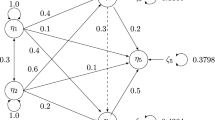Summary
The maximum likelihood (ML) estimator and its modification in the linear functional relationship model with incidental parameters are shown to be third-order asymptotically efficient among a class of almost median-unbiased and almost mean-unbiased estimators, respectively, in the large sample sense. This means that the limited information maximum likelihood (LIML) estimator in the simultaneous equation system is third-order asymptotically efficient when the number of excluded exogenous variables in a particular structural equation is growing along with the sample size. It implies that the LIML estimator has an optimum property when the system of structural equations is large.
Similar content being viewed by others
References
Akahira, M. and Takeuchi, K. (1981).The Concept of Asymptotic Efficiency and Higher Order Efficiency in Statistical Estimation Theory, No. 7, Springer-Verlag.
Anderson, T. W. (1974). An asymptotic expansion of the limited information maximum likelihood estimate of a coefficient in a simultaneous equation system,J. Amer. Statist. Ass.,69, 565–572.
Anderson, T. W. (1976). Estimation of linear functional relationships: approximate distributions and connections with simultaneous equations in econometrics,J. R. Statist. Soc.,B38, 1–38.
Anderson, T. W. (1984). Estimating linear functional relationships,Ann. Statist.,12, 1–45.
Anderson, T. W. and Sawa, T. (1979). Evaluation of the distribution function of the two-stage least squares estimate,Econometrica,47, 163–183.
Anderson, T. W., Kunitomo, N. and Sawa, T. (1982). Evaluation of the distribution function of the limited-information maximum likelihood estimator,Econometrica,50, 1009–1027.
Anderson, T. W., Kunitomo, N. and Morimune, K. (1986). Comparing single equation estimators in a simultaneous equation system,Econom. Theory,2, 1–32.
Fujikoshi, Y., Morimune, K., Kunitomo, N. and Taniguchi, M. (1982). Asymptotic expansions of the distributions of the estimates of coefficients in a simultaneous equation system,J. Econometrics,18, 191–205.
Fuller, W. A. (1977). Some properties of a modification of the limited information estimator,Econometrica,45, 939–953.
Ghosh, J. K., Sinha, B. K. and Wieand, H. S. (1980). Second order efficiency of the MLE with respect to any bounded bowl-shaped loss function,Ann. Statist.,8, 506–521.
Kunitomo, N. (1980). Asymptotic expansions of the distributions of estimators in a linear functional relationship and simultaneous equations,J. Amer. Statist. Ass.,75, 693–700.
Kunitomo, N. (1981). Asymptotic optimality of the limited information maximum likelihood estimator in large econometric models,Economic Studies Quarterly,XXXII, 247–266.
Kunitomo, N. (1982). Asymptotic efficiency and higher order efficiency of the limited information maximum likelihood estimator in large econometric models,Tech. Rep. No. 365, Institute for Mathematical Studies in the Social Sciences, Stanford University.
Kunitomo, N. (1986). Comparing some modified maximum likelihood estimator of a slope coefficient in a linear functional relationship.J. Japan Statist. Soc.,16, 173–185.
Morimune, K. (1983). Approximate distributions ofk-class estimators when the degree of overidentifiability is large compared with the sample size,Econometrica,51, 821–841.
Morimune, K. and Kunitomo, N. (1980). Improving the maximum likelihood estimate in linear functional relationships for alternative parameter sequences,J. Amer. Statist. Ass.,73, 867–871.
Pfanzagl, J. and Wefelmeyer, W. (1978). A third order optimum property of the maximum likelihood estimator,J. Multivariate Anal.,8, 1–29.
Takeuchi, K. (1972).Contributions to the Theory of Statistical Inference in Econometrics (in Japanese), Toyokeizai-Shinposha, Tokyo.
Takeuchi, K. and Morimune, K. (1985). Asymptotic completeness of the extended maximum likelihood estimators in a simultaneous equation system,Econometrica,53, 177–200.
Author information
Authors and Affiliations
Additional information
The research was partly supported by National Science Foundation Grant SES 79-13976 at the Institute for Mathematical Studies in the Social Sciences, Stanford University and Grant-in-Aid 60301081 of the Ministry of Education, Science and Culture at the Faculty of Economics, University of Tokyo. This paper was originally written as a part of the author's Ph.D. dissertation submitted to Stanford University in August, 1981. Some details of the paper were deleted at the suggestion of the associate editor of this journal.
About this article
Cite this article
Kunitomo, N. A third order optimum property of the ML estimator in a linear functional relationship model and simultaneous equation system in econometrics. Ann Inst Stat Math 39, 575–591 (1987). https://doi.org/10.1007/BF02491491
Received:
Revised:
Published:
Issue Date:
DOI: https://doi.org/10.1007/BF02491491



